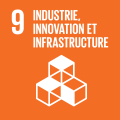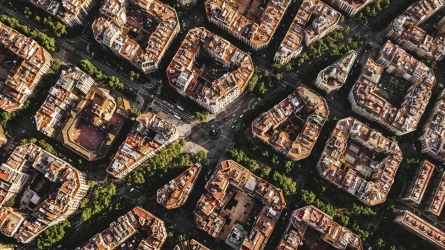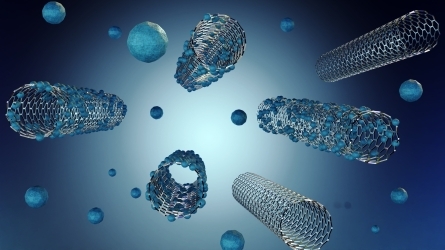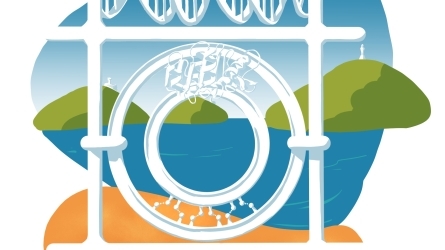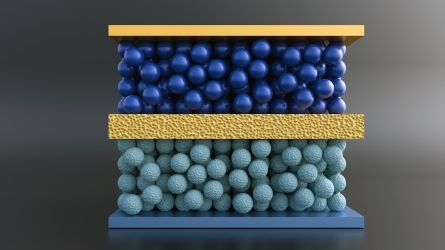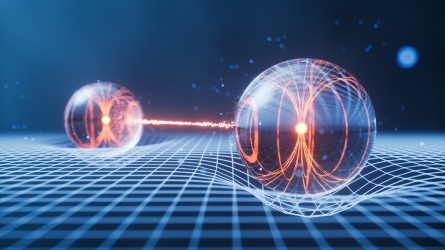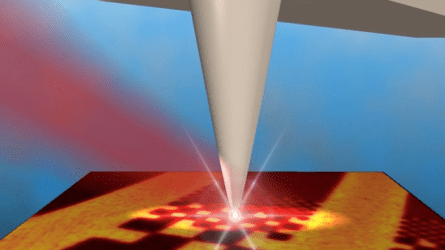
Near-field Optical Nanoscopy Summer School
Azalpena
Ongi etorria Near-field Optical Nanoscopy Summer Schoolen lehen ediziora. Honako alderdi hauek jorratuko ditugu: instrumentazioa, metodologia, datuen analisia, alderdi praktikoak eta aplikazio potentziala eremu hurbileko dispertsio bidezko ekortze mikroskopia optikoan (s-SNOM), nanoespektroskopia infragorrian (nano-FTIR) eta lotutako tekniketan.
Irudi optikoak lortzeko eta espektroskopiako puntako tresnak dira s-SNOM mikroskopia eta nano-FTIR espektroskopia, eta nanoeskalako irudiak lortzeko aukera ematen dute, maiztasun ikusgaien eta terahertzekoen artean dagoen espektro gama zabalean.
Lehen aldiz merkaturatu zirenetik, duela 15 urte inguru, hainbat irudi eta espektroskopia modalitate berri garatu dira, azkar handitzen ari den erabiltzaile komunitate baten zerbitzura askotariko eta diziplinarteko arloetan, hala nola egoera solidoaren fisikan, erdieroaleen teknologian, fotonikan, polimeroen zientzian eta biologian.
Programa hau elkarrekin diseinatu dute hiru erakundek –CIC nanoGUNE BRTA (www.nanogune.eu, Donostia), ENSEMBLE3 Centre of Excellence (www.ensemble3.eu, Varsovia, Polonia) eta neaspec/attocube AG (www.neaspec.com, Munich, Alemania)–, eremu hurbileko nanoskopia optikoari buruzko prestakuntza, eztabaida eta sareen sorrerako ekitaldi baten eskaera gero eta handiagoari erantzuteko.
Donostian zuri ongietorria eman ahal izatea espero dugu.
Antolakuntza Batzordea
Adrian Cernescu (attocube systems AG)
Rainer Hillenbrand (Ikerbasque Research professor, CIC nanoGUNE BRTA) Monika Goikoetxea (CIC nanoGUNE BRTA)
Helburuak
Aukera paregabea eskaini nahi diegu s-SNOMen erabiltzaileei –bereziki berriei–, adituen eskutik ezagutzak lortzeko oinarrizko printzipio, tresneria, teknika, metodo eta aplikazio ahalmenari buruz, baita trikimailu eta aholku praktikoen berri izateko ere. Horrela, indartu egingo da handitzen ari den diziplinarteko komunitate hau, eta komunikazioa eta lankidetza sustatuko dira. Tailerra presentziala izango da.
Jarraibideak eta eskaera formularioa:
Near-field Optical Nanoscopy Summer School ikertzaileei eta ikasleei zuzenduta dago, eta eremu hurbileko dispertsio bidezko ekortze mikroskopia optikoaren eta lotutako tekniken oinarriak eta aplikazioak ezagutaraztea du helburu.
Parte hartzaile kopurua mugatua izango da. Motibazio adierazpenaren arabera hautatuko dira parte hartzaileak. Espero dena baino askoz eskaera gehiago jasoz gero, litekeena da ikertalde bakoitzeko pertsona bakarra onartu behar izatea.
Poster bat aurkeztu dezaten proposatzen diegu parte hartzaileei, alderdi instrumental, metodologiko eta datuen analisiari buruzkoa. Bereziki ongi etorriak izango dira erronka, arazo eta horien balizko konponbideei buruzko eztabaidak. Espektroskopia eta irudi emaitzei buruzko eztabaida mugatu egin beharko da. Poster bidezko saioetan, esperientziak trukatzeko eta beste parte hartzaile eta hizlari batzuen feedbacka jasotzeko aukera izango dute parte hartzaileek.
Eskaera egiteko epea itxita. Hautaketa-prozesuaren emaitzak 2023ko martxoaren hasieran jakinaraziko dira, eta hautatutako parte-hartzaileek izena ematen jarraitu ahal izango dute (izena emateko kuota: 200 €).
Jarduera nori zuzenduta
- Unibertsitateko ikaslea
- Profesionalak
- Investigadores
Zuzendariak

Rainer Hillenbrand
CIC nanoGUNE
Rainer Hillenbrand is an Ikerbasque Research Professor and Nanooptics Group Leader at the nanoscience research center CIC nanoGUNE BRTA in San Sebastian (Basque Country, Spain), and a Joint Professor at the University of the Basque Country. He is also co-founder of the company neaspec GmbH (Germany), which develops and manufactures near-field optical microscopes. From 1998 to 2007 he worked at the Max-Planck-Institute for Biochemistry (Martinsried, Germany), where he led the Nano-Photonics Research Group from 2003 to 2007. He obtained his PhD degree in physics from the Technical University of Munich in 2001. Hillenbrand pioneered the development of infrared near-field nanoscopy and nanospectroscopy, and its applications in nanophotonics, polaritonics, materials sciences and soft matter sciences. In 2014 he received the Ludwig-Genzel-Price “for the design and development of infrared near-field spectroscopy and the application of the novel spectroscopy method in different fields of natural sciences”.

Monika Goikoetxea Larruskain
CIC nanoGUNE
Monika Goikoetxea is the Lab Manager of Nanooptics group and lecturer in the Department of Advanced Polymers and Materials: Physics, Chemistry, and Technology at the University of Basque Country (UPV-EHU). She obtained her PhD in Chemistry in 2006 from the Chemical Engineering group (UPV-EHU) and subsequently worked as a post-doctoral researcher at POLYMAT, where she specialized in the synthesis of hybrid nanoparticles for coating applications. She utilized knowledge-based strategies to control molecular architecture, particle morphology, and film morphology. In 2009, she joined UPV-EHU as part of the "Grants for the Specialization of UPV-EHU PhD Researchers" program with a project related to the development of polymer nanoparticles with controlled morphology and began her research on renewable raw materials. In 2017, she joined the Nanooptics group, where she focused on the application of s-SNOM and nano-FTIR on polymeric materials and other organic and biological samples. She is currently a member of the E3 team and is focused on developing s-SNOM education activities for the ENSEMBLE3 Centre of Excellence.
Hizlariak

Pablo Alonso González
University of Oviedo-Asturias
Prof. Pablo Alonso-González holds a Distinguished Researcher position at the University of Oviedo (Spain) where he leads the Quantum Nanooptics Lab at the Department of Physics. He obtained his PhD degree in Physics from the Universidad Autónoma de Madrid (2009). From 2009 to 2015 he was post-doctoral researcher at the Nanooptics group at CIC nanoGUNE in San Sebastian (Basque Country, Spain). Alonso-González´s research activities are focused on materials science and nanophotonics with special emphasis on the study of the opto-electronic properties of novel 2D materials at the nanoscale. In 2014 he received the Spanish Royal Society of Physics (RSEF-BBVA) prize in the category of young experimental scientist, and in 2021 he was selected as finalist for the Falling Walls Science Breakthroughs of the Year 2021 in Physical Sciences. In 2016 and 2022 he was awarded by the European Research Council (ERC) with a Starting and a Consolidator Grant, respectively.

Antonio Ambrosio
Istituto Italiano di Tecnologia
Antonio Ambrosio holds a Master degree in Condensed Matter Physics from the University of Naples Federico II and a PhD degree in Applied Physics from the University of Pisa. He has been researcher at the Consiglio Nazionale delle Ricerche and in 2013, visiting Research Scholar of the John A. Paulson School of Engineering and Applied Sciences of the Harvard University, collaborating with the group of Prof. Federico Capasso in building a nano-imaging spectroscopic facility that allowed imaging of the steered surface plasmon polaritons in one- and two-dimensional metamaterials. Between July 2016 and August 2019, Antonio was Principal Scientist at the Center for Nanoscale Systems at Harvard where he has continued his research activities in nano-photonics. He is now PI of the research line named Vectorial Nano-imagingat the Center for Nano Science and Technology (CNST) of IIT in Milan, dedicated to the development of metasurface-based optical nano-devices and new optical near-field imaging and spectroscopy techniques for 2D materials, polymers and nanostructured surfaces.

Dmitri Basov
Columbia University
Dmitri N. Basov (PhD 1991) is a Higgins professor and Chair of the Department of Physics at Columbia University [http://infrared.cni.columbia.edu], the Director of the DOE Energy Frontiers Research Center on Programmable Quantum Materials and co-director of Max Planck Society – New York Center for Nonequilibrium Quantum Phenomena. He has served as a professor (1997-2016) and Chair (2010-2015) of Physics, University of California San Diego. Research interests include: physics of quantum materials, superconductivity, two-dimensional materials, infrared nano-optics. Prizes and recognitions: Sloan Fellowship (1999), Genzel Prize (2014), Humboldt research award (2009), Frank Isakson Prize, American Physical Society (2012), Moore Investigator (2014, 2020), K.J. Button Prize (2019), Vannevar Bush Faculty Fellowship (U.S. Department of Defense, 2019), National Academy of Sciences (2020).

Adrian Cernescu
Dr. Adrian Cernescu is an experienced Application Engineer from neaspec - attocube systems AG, supporting and advising scientists to use and apply neaspec instruments for optical characterization of nanomaterials. His research and experience with near-field optical applications started in 2012 during his post-doctoral fellowship with Dr. Fritz Keilmann, one of the pioneers of near-field optics, at the Ludwig Maximilian University, Munich. Having a PhD in Physical Chemistry and a Master degree in Biophysics, Adrian has a broad interest in Materials & Applied Science where nanoscale optical and chemical analysis provides unmatched insights for research and industrial innovation.

Yasin Celaleddin Durmaz
attocube systems AG

Lukas M. Eng
IAP, TU Dresden
Lukas M. Eng is Full Professor at the Excellence-University “Technische University Dresden (TUD), Germany”. His focus lies on experimentally exploring the nanoscale electronic, optical, and magnetic properties of modern-type low-dimensional and/or topological materials, by applying various scanning-probe-microscopy-based methods at room and low temperatures. He received a PhD and venia legendi from the University of Basel, Switzerland, and then was hired at TUD after several post-doctoral experiences, nominally in Molecular Electronic Devices (BASF AG, Germany), Biophysics (Univ. Geneva, CH) and Nonlinear and Quantum Optics (ETH Zürich, CH). – https://tu-dresden.de/mn/physik/iap/experimentalphysik-photophysik#intro

Raul Freitas
LNLS Brazil
Raul O. Freitas has been a staff scientist at the Brazilian Synchrotron Light Laboratory (LNLS) since 2012. He specializes in Synchrotron Infrared Nanospectroscopy (SINS), near-field optics and interferometry, IR beamlines optical design, and Fourier Transform Infrared Spectroscopy (FTIR). He oversees the construction and operation of the LNLS IR1 beamline and the new IMBUIA beamline in the Sirius accelerator, with a focus on nanoscale vibrational properties of materials. He previously worked in synchrotron X-ray diffraction and holds a PhD from the University of Sao Paulo (USP) and the University of Guelph (UoG/Canada). Dr. Freitas is an active reviewer for scientific journals and is currently the chair of the peer-review committee of the Canadian Light Source. Before academia, he worked as a designer in the engineering department of a multinational company in the fuels distribution business.

Tobias Gokus
obias Gokus is an application engineer in the nanoscale analytics team of neaspec- attocube systems AG. He received his PhD in Physical Chemistry at LMU Munich, Germany in 2011 focusing on optical microscopy and spectroscopy methods for studying individual carbon nanotubes and graphene. Being intrigued by the unique capabilities and application potential of infrared near-field microscopy he joined neaspec GmbH in 2012. In his current position Tobias is exploring together with scientists from academia and industry new applications of s-SNOM near-field imaging and spectroscopy technology.

Alexander Govyadinov Govyadinov
attocube systems AG
Alexander (Sasha) Govyadinov received his PhD from Oregon State University, USA, in 2007 specializing in computational optics and physics of metamaterials. He then worked in the University of Pennsylvania before moving to Spain in 2011, where he developed the theory of s-SNOM in the group of Rainer Hillenbrand (CIC Nanogune). In 2018, Sasha has joined attocube in the role of product manager responsible for the development of neaspec microscopes. Alexander is an author of four patents and two dozens of peer reviewed publications including key works on the understanding of nearfield image contrast, nano-FTIR spectroscopy, as well as on the methods of extraction of dielectric constants from s-SNOM measurements.

Fritz Keilmann Keilmann
Ludwig-Maximilians-Universität München
Fritz Keilmann (*1942) studied meteorology, biophysics and physics in Munich. As a postdoc he worked from 1972 at MIT on precision spectroscopy and invented a record-strong gas laser tunable from microwave to infrared frequencies. This enabled him, from 1974 at the MPI for Solid State Physics (Stuttgart), to pioneer coherent phonon propagation and nonlinear infrared spectroscopy of dielectrics and semiconductors, even ultrafast dynamics. He advanced optics instrumentation with all-metal polarizers and filters which he commercialized (Lasnix) in 1984. His all-metal infrared focusing helped him understanding quantum-Hall physics and achieving, from 1995 at the MPI for Biochemistry (Martinsried), super-resolution near-field optical microscopy (s-SNOM) which he and R. Hillenbrand commercialized (Neaspec) in 2007. He pioneered both dual-frequency-comb spectroscopy and, from 2007 at the MPI of Quantum Optics (Garching), infrared supercontinuum sources for s-SNOM to perfect nano-FTIR chemical nanoscopy. In 2009 he was awarded the K.J. Button prize. Since retiring from Max-Planck (2012) and from Neaspec (2017) he continues at the LMU physics department pioneering (2021) nano-FTIR of cells living in their aqueous environment.

Frank Koppens
ICFO
Prof. Frank Koppens obtained his PhD in experimental physics at Delft University, at the Kavli Institute of Nanoscience, The Netherlands. After a postdoctoral fellowship at Harvard University, Since August 2010, Koppens is group leader at the Institute of Photonic Sciences (ICFO). The quantum nano-optoelectronics group of Prof. Koppens focuses on both science and technology of novel two-dimensional materials and quantum materials. Prof. Koppens is vice-chairman of the executive board of the graphene flagship program, a 1000 MillionEuro project for 10 years. He is also the leader of the optoelectronics workpackage within the flagship. Koppens has received numerous ERC awards: the ERC starting grant, the ERC consolidator grant, and four ERC proof-of-concept grants. Other awards include the Christiaan Hugyensprijs 2012, the national award for research in Spain, the IUPAP young scientist prize in optics, and the ACS photonics investigator award. Since 2018 Koppens is on the Clarivate list for highly cited researchers, in the physics category. Koppens has been elected as fellow of the American Physical Society in 2022. In total, Koppens has published more than 120 refereed papers (H-index 69).

Lars Mester
attocube systems AG
I am application engineer for the Neaspec team of attocube and long-time user of near-field microscopy. My background is solid state physics (RWTH Aachen University) and I was introduced to the s-SNOM technology already during my Master’s studies in the Nano-optics group of Prof. Thomas Taubner. During five years in San Sebastian, I have worked in the group of Prof. Rainer Hillenbrand at nanoGUNE with infrared near-field microscopy on a broad range of samples ranging from polymer, bio, semiconductor, 2D materials and others. As application engineer of attocube I am now involved in an even broader range of projects, spanning spectral ranges from visible to terahertz, experiments at cryogenic temperatures and more.

Iris Niehues
CIC nanoGUNE BRTA
Dr. Iris Niehues is currently a postdoctoral researcher (DFG Fellowship) in the group of Prof. Rainer Hillenbrand at the nanoscience research center CIC nanoGUNE BRTA in San Sebastian. Her project focusses on the optical properties of single-photon emitters in hexagonal Boron Nitride on the nanoscale using s-SNOM, nano-FTIR and TEPL techniques. Iris Niehues studied physics at the University of Münster (2010-2015) focussing on solid state physics and optics. Already for her master thesis she investigated the optical properties of 2D materials and their manipulation on the nanoscale. She continued her research in this field during her PhD (2015-2020) where she used mechanical strain to control the excitons (bound electron hole pairs) and their interplay with phonons (lattice vibrations) in 2D semiconductors. Both her master and PhD thesis were supervised by Prof. Rudolf Bratschitsch and were awarded with the best thesis of the year in the physics department at the University of Münster.
Prof. Dorota A. Pawlak (DAP) is the president of the newly established Centre of Excellence for nanophotonics, advanced materials and novel crystal growth-based technologies, ENSEMBLE3 in Warsaw, Poland (www.ensemble3.eu). She leads the Functional Materials Technology group which works on new materials with special optical properties and potential applications in such fields as photonics, optoelectronics, medicine and photoelectrochemistry. DAP proposed utilization of crystal growth and eutectic solidification for realization of new material types such as metamaterials, plasmonic materials, topological insulator heterostructures, or novel materials for hydrogen generation. Together with her group they invented a direct method, Nanoparticles Direct Doping method, for producing volumetric glass-based composites doped with various species including plasmonic nanoparticles, quantum dots, rare earth ions. She is a laureate of highly competitive projects including Teaming for Excellence H2020, International Research Agenda Programme and TEAM projects by the Foundation for Polish Science, or MAESTRO from the National Science Centre in Poland. DAP is also the president-elect of the Polish Society for Crystal Growth.

Claas Reckmeier
attocube
Dr. Claas Reckmeier is an experienced Application Scientist in the product management team of neaspec - attocube systems AG. With a background in Biophysics (LMU Munich) and a PhD degree in Physics & Materials Science from City University of Hong Kong, Claas is close to applied science and research. At attocube, he works on bringing high usability and accessibility to the challenging field of nanoscale resolution microscopy. A recent focus at neaspec is to provide a set of advanced correlative microscopy modes covering broad range of applications, enabling our customers in both industry and science to gain unprecedented insight into material properties at the nanoscale and to develop the building blocks of future technology.

Thomas Taubner
RWTH Aachen University
Prof. Dr. Thomas Taubner obtained his PhD in 2004 at the Technical University Munich (TUM) for his work on spectroscopic infrared near-field microscopy under supervision of Dr. Fritz Keilmann. After a two-year Postdoc at the MPI for Biochemistry with Rainer Hillenbrand he moved in 2006 to Stanford University, where he worked in the field of „Plasmonics“ with Prof. Mark Brongersma. Since 2008 he is Professor for Nano-Optics and Metamaterials at RWTH Aachen University. His research is devoted to the development and application of new imaging and spectroscopy methods in the mid-infrared spectral range. He was investigating the fundamentals of scanning near-field optical microscopy (s-SNOM), with focus on IR vibrations in molecules and polar crystals and subsurface imaging, and the nanoscale imaging with super- and hyperlenses using phonon polaritons. Currently research interests are IR nanospectroscopy of interband transitions in layered 2D materials and tunable metasurfaces using Phase Change materials.

Martin Schnell
CIC nanoGUNE

Vladimir Zenin
University of Southern Denmark
I was born in the far east of USSR in 1987. Then I grew up in Ukraine, with my mother being a math teacher, and my grandmother being a teacher in physics. No surprise I was good at these subjects, however, my deep interest in physics has begun later in a high school, thanks to my teacher Nikolay F. Babenko. I was quite good in solving challenging physical problems, therefore I participated (with a certain success) in All-Ukrainian Olympics in Physics. Then I entered Moscow Institute of Physics and Technology (State University), the best university for physicists in post-soviet area at that time. First, I went hard-core into theoretical physics direction, but later found it boring and hopeless, therefore I switched then into experimental physics. By a pure coincidence I was invited to Odense, Denmark, by prof. Sergey I. Bozhevolnyi (University of Southern Denmark), which was a completely new world for me. I liked this world and put all my efforts into staying here. One year later, my efforts were rewarded, and I got a PhD position in his group. Since then, I got stuck here, because I like living in Denmark as a whole and working environment in our group in particular. Currently I enjoy my life with my lovely wife Oksana, daughter A
Matrikula prezioak
| Matrikula | 2023-05-17 arte |
|---|---|
| 200,00 EUR | |
| 0 EUR | |
| 0 EUR |
Kokalekua
Miramar Jauregia
Mirakontxa pasealekua 48, 20007 Donostia
Gipuzkoa
Miramar Jauregia
Mirakontxa pasealekua 48, 20007 Donostia
Gipuzkoa
Sustainable development goals
2030 Agenda da nazioarteko garapenerako agenda berria. Nazio Batuen Erakundeak onartu zuen 2015eko irailean eta giza garapen jasangarriaren aldeko tresna eraginkorra izan nahi du planeta osoan. Haren zutabe nagusiak dira pobrezia errotik desagerraraztea, zaurgarritasunak eta desberdintasunak urritzea, eta jasangarritasuna bultzatzea. Aukera paregabea eskaintzen du mundua 2030. urtea baino lehen aldatzeko eta pertsona guztien giza eskubideak bermatzeko.
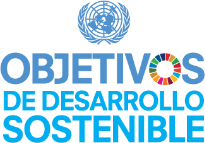
9 - Industria, berrikuntza eta azpiegitura
Azpiegitura erresilienteak eraikitzea, industrializazio inklusiboa eta jasangarria sustatzea, eta berrikuntza bultzatzea. Gai gakoak: azpiegitura fidagarriak, jasangarriak, erresilienteak eta kalitatezkoak, industrializazio inklusibo eta jasangarria, modernizazioa, teknologia eta prozesu industrial garbiak eta ingurumenaren aldetik arrazionalak, ikerketa zientifikoa eta gaitasun teknologikoaren hobekuntza, IKTetarako sarbide unibertsala.
Informazio gehiago